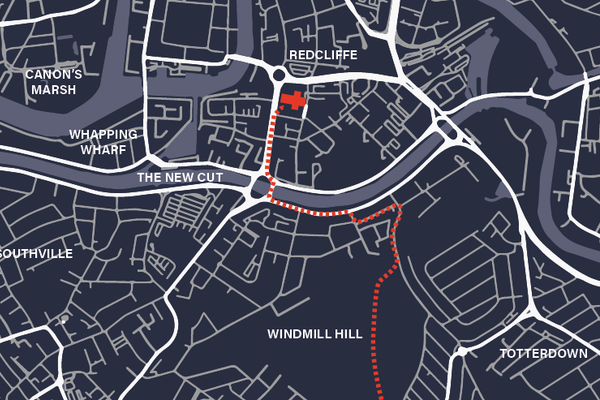Copyrighting Cartography with Fictional Places
Thomas Brothers Map Co. map of East LA (1966), one of the many companies to include trap streets (via david/Flickr user)
With all the time and energy cartographers spend preparing maps, it makes sense that they would want to protect their investment. One of the ways they do so — although they don’t always admit it — is by including “trap streets,” deliberate mistakes added to maps to catch unsuspecting copyright violators. These may include fake streets, as the name suggests, but the term is also applied to other erroneous cartographic data included to embarrass those who might steal it. Usually, these “mistakes” are minor: tiny (and entirely false) bends in rivers and roads, or slightly altered mountain elevations.
The TeleAtlas Directory, the basis for Google Maps, is said to have included several trap streets. According to a 2012 article in Cabinet, Moat Lane once curved its way through North London, at least in the regular view of on Google Maps, although the satellite layer revealed that the place where the lane was supposed to exist was a disparate collection of trees and houses — there was no lane there at all.
Other TeleAtlas/Google Maps trap streets have included Oxygen Street, which supposedly ran between two houses in Edinburgh (it didn’t), Adolph-Menzel-Ring and Otto-Dix-Ring, both attached to Wiesenstrasse in Zeuthen, Germany (they weren’t), and Kerbela Street, which purportedly ran through the Shropshire Learners & Driving Instructor Training Center in Shrewsbury, England (it never existed).
Perhaps the strangest trap street is the phantom town of Argleton, England, which appeared on Google Maps as recently as 2009. Online listings showed the town as having jobs, real estate, weather forecasts, and even a single scene. But no one had ever set foot there, because it doesn’t exist. Google has since removed the town from their listings, and though many speculate that it was a town-wide version of a trap street, the company wouldn’t reveal if its inclusion was a deliberate attempt to catch thieves.
The empty field where Argleton was charted to be (via small-town hero/Wikimedia)
Most map-makers deny including trap streets, and there are plenty of other ways that errors find their way into maps. (These include “paper streets,” planned by developers and included on blueprints, but never actually built.) However, in the 1980s, the vice president of Thomas Brothers maps revealed that the company sprinkled fictitious streets around their Los Angeles guides. In an interview with the Los Angeles Times, the vice president said that San Bernadino and Riverside counties has the strongest concentration of fake streets, between 100 and 200 of them.
In America, trap streets themselves are not copyrightable, ever since Alexandria Drafting Co. v. Amsterdam ruled in 1997 that “the existence, or non-existence, of a road is a non-copyrightable fact.” In the United Kingdom, however, things are different. In 2001, the UK’s Automobile Association agreed to pay agreed to pay £20,000,000 after it was caught copying Ordnance Survey maps. The theft was revealed thanks to tiny design fingerprints in the Ordnance Survey maps, like the width of roads, rather than entirely fake streets.
Map-makers are far from the only ones to use copyright traps. Dictionaries are frequent culprits: recent editions of the New Oxford American Dictionary included the word “esquivalience” (defined as “the willful avoidance of one’s official responsibilities”), which was later shown to be entirely made up, just to catch would-be plagiarists. Such lexicographical traps are sometimes called Mountweazels, after the entry for Lillian Virginia Mountweazel in the 1975 New Columbia Encyclopedia. Mountweazel was apparently a fountain designer-turned-photographer celebrated for her photographs of rural American mailboxes; alas, she never lived. Richard Steins, one of the volume’s editors, told The New Yorker: “If someone copied Lillian, then we’d know they’d stolen from us.”
Bess Lovejoy is a writer, researcher, and editor based in Brooklyn. Her book Rest in Pieces was published last year by Simon & Schuster.











Follow us on Twitter to get the latest on the world's hidden wonders.
Like us on Facebook to get the latest on the world's hidden wonders.
Follow us on Twitter Like us on Facebook